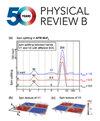Variationally optimizing infinite projected entangled-pair states at large bond dimensions: A split corner transfer matrix renormalization group approach
IF 3.7
2区 物理与天体物理
Q1 Physics and Astronomy
引用次数: 0
Abstract
Projected entangled-pair states (PEPS) have become a powerful tool for studying quantum many-body systems in the condensed matter and quantum materials context, particularly with advances in variational energy optimization methods. A key challenge within this framework is the computational cost associated with the contraction of the two-dimensional lattice, crucial for calculating state vector norms and expectation values. The conventional approach, using the corner transfer matrix renormalization group (CTMRG), involves combining two tensor network layers, resulting in significant time and memory demands. In this work, we introduce an alternative split-CTMRG algorithm, which maintains separate PEPS layers and leverages modified environment tensors, reducing computational complexity while preserving accuracy. Benchmarks on quantum lattice models demonstrate substantial speedups for variational energy optimization, rendering this method valuable for large-scale PEPS simulations.大键维下无限投影纠缠对态的变分优化:分角转移矩阵重整化群方法
随着变分能量优化方法的进步,投射纠缠对态(pep)已成为研究凝聚态和量子材料中量子多体系统的有力工具。该框架中的一个关键挑战是与二维晶格收缩相关的计算成本,这对于计算状态向量规范和期望值至关重要。传统的方法,使用角转移矩阵重整化群(CTMRG),涉及两个张量网络层,导致大量的时间和内存需求。在这项工作中,我们引入了一种替代的分裂- ctmrg算法,该算法保持单独的PEPS层并利用修改的环境张量,在保持准确性的同时降低了计算复杂度。量子点阵模型的基准测试证明了变分能量优化的显著加速,使该方法对大规模PEPS模拟有价值。2025年由美国物理学会出版
本文章由计算机程序翻译,如有差异,请以英文原文为准。
求助全文
约1分钟内获得全文
求助全文
来源期刊

Physical Review B
物理-物理:凝聚态物理
CiteScore
6.70
自引率
32.40%
发文量
0
审稿时长
3.0 months
期刊介绍:
Physical Review B (PRB) is the world’s largest dedicated physics journal, publishing approximately 100 new, high-quality papers each week. The most highly cited journal in condensed matter physics, PRB provides outstanding depth and breadth of coverage, combined with unrivaled context and background for ongoing research by scientists worldwide.
PRB covers the full range of condensed matter, materials physics, and related subfields, including:
-Structure and phase transitions
-Ferroelectrics and multiferroics
-Disordered systems and alloys
-Magnetism
-Superconductivity
-Electronic structure, photonics, and metamaterials
-Semiconductors and mesoscopic systems
-Surfaces, nanoscience, and two-dimensional materials
-Topological states of matter
 求助内容:
求助内容: 应助结果提醒方式:
应助结果提醒方式:


